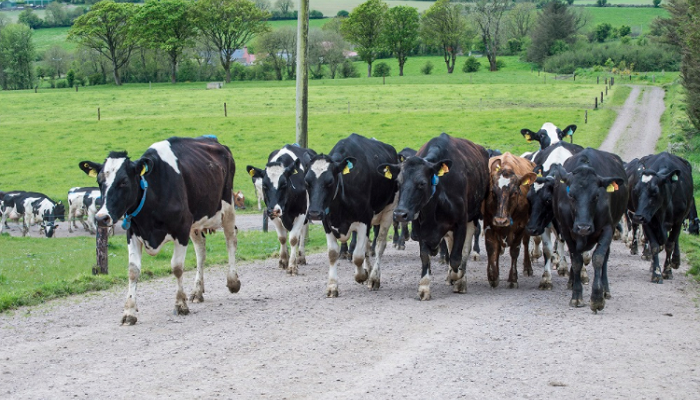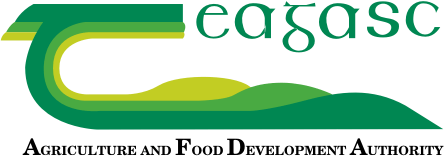23 January 2023
Dairy production costs and projections 2022-2023

The average unit cost of producing milk has increased since the abolition of quotas. The rate of increase in costs from 2015 to 2017 was 1.9% per year.
In the period 2017-2018, this rate increased to 3.4% per year. However over the last two years as input price inflation has risen dramatically, the cost of producing milk has increased at a significantly higher rate. Based on data collected from the new Teagasc eProfit Monitor system, the average cost of keeping a cow in 2021 for a spring calving dairy farmer was €1,656/cow (range from €1,198/cow to €2,211/cow). This figure includes the cost of keeping the cow and also her replacement heifer costs and is expressed on a per cow basis.
Summary
- Input price inflation is likely to increase the cost of production to €2,218/cow on average based on projected costs from eProfit Monitor data.
- Direct costs associated with feeding the cow have increased to 51% of total costs.
- Changes in cow numbers should be assessed taking into account cost and source of feed, overhead costs, and implications for labour requirement. Assuming a linear change based on current costs can be misleading.
Projecting a final cost of milk production for 2022-2023
To budget forward to examine the costs for 2022 we used the following input cost assumptions:
- Same quantity of inputs as 2021;
- Average meal price of €415/t in 2022;
- Fertilizer cost increase by 250%;
- Contractor cost increase by 50%Total variable costs on average increase by 49%10% increase in fixed costs.
When these are used in a cumulative projection, average costs is projected to have increased from €1,656/cow to €2,218/cow. This is equivalent to a 33% increase in the cost of production, which will equate to an average cost of 37.84c/litre for 2022. To put this in context, the average Gross Output on Teagasc eProfit Monitors over the last five years (2017-2021) has been 40.88c/litre. It is clear therefore that the final margins achieved on dairy farms in 2022 will have been almost entirely dependent on the higher milk price returned.
Looking forward to 2023 we are likely to see a further increase in concentrates costs, while other costs will likely increase at an inflation rate of 8% leading to total costs per cow increasing to €2,331. This underlines the need for dairy farmers to maintain close control on costs despite a seemingly high milk price, to prioritize investment in high return areas such as soil fertility, and to stress-test capital expenditure projects against possible changes to base milk price.
Table 1: Projected costs for 2022 (spring calving 2021 vs 2022)
| Costs/cow | Costs C/L | |||||
|---|---|---|---|---|---|---|
| 2021 | 2022 (Proj.) | Diff +/- | 2021 | 2022 | Diff +/- | |
| Feed | 372 | 524 | 151 | 6.35 | 8.93 | 2.58 |
| Fertiliser | 158 | 394 | 236 | 2.69 | 6.73 | 4.04 |
| Vet | 84 | 93 | 9 | 1.44 | 1.58 | 0.14 |
| AI | 46 | 51 | 5 | 0.79 | 0.87 | 0.08 |
| Contractor | 149 | 223 | 74 | 2.54 | 3.81 | 1.27 |
| Other variable costs | 183 | 201 | 18 | 3.12 | 3.43 | 0.31 |
| Total variable costs | 992 | 1486 | 494 | 16.93 | 25.35 | 8.42 |
| Total fixed costs | 664 | 732 | 68 | 11.33 | 12.49 | 1.16 |
| Total costs | 1656 | 2218 | 562 | 28.26 | 37.84 | 9.58 |
Impact of feed budget balance on milk production costs
The projections shown illustrate that the trajectory of production costs has risen steeply. However, in particular the direct costs of feeding the herd (purchased concentrate and forage, fertilizer and contractor) have increased faster than the overall average. In fact in 2022 51% (€1,141/cow) of the cost of production will be associated with direct feed costs. This proportion has increased from 41% in 2021. Therefore, as we look forward and want to control costs, it is essential to manage the feed budget and overall projected feed balance for the farm. This will have the biggest impact on cost structure going forward. An analysis of 2021 eProfit Monitor data looks at whole farm stocking rate compared to the purchased feed cost on spring calving herds.
Table 2: Purchased fodder compared to stocking rates
| Purchased concentrate | Bought in forage | Whole farm stocking rate | Grass utilised | ||
|---|---|---|---|---|---|
| kg MS/cow | Tonnes/cow | kg DM/cow | LU/ha | (t/ha) | |
| Average farmer (n=739) | 492 | 1.05 | 138 | 2.33 | 10.01 |
| No forage purchased (n=321) | 486 | 1.01 | 0 | 2.21 | 9.84 |
| Buying above 200kg DM (n=177) | 501 | 1.15 | 443 | 2.47 | 9.75 |
Based on this real farm data, some farmers are deciding to stock the farm to buy no imported fodder, while others are stocking beyond the potential grass grown of the farm and purchasing back the additional fodder required. To explore the impact this will have on the cost structure of the farm, we standardized the farm to a 40 Ha block and assumed only cows on the farm. Two stocking rates scenarios were examined i.e. self-sufficient for forage at moderate stocking rate, or the higher stocking rate with additional cows supported by importing feed into the system. Annual pasture growth was assumed to be similar across the scenarios.
If stocked at the moderate SR the farm will carry 88 cows (40 X 2.21). If they run the farm at the higher SR they will carry 98 cows (40 x 2.47). To carry the additional cows no additional grass was grown and in fact grass utilized figures declined from 9.84t/ha to 9.75. The additional costs to keep the 10 extra cows to the feed budget were 0.14t/ of meal per cow and 443kg DM of purchased forage. This may not appear significant expressed on a ‘per cow in the herd’ basis, however it is useful to isolate the effect to the extra 10 cows, as these are the cohort creating change in the feed budget.
Table 3: Effect of stocking rate and feed input pricing on herd feed cost
| Moderate SR | Higher SR | ||
|---|---|---|---|
| Total cows | 88 | 98 | |
| Pruchased meal (t as fed) | 92 | 113 | |
| Purchased silage (t DM) | 0 | 42.14 | |
| Per Extra cow | |||
| Feed budget (meal €400/t; silage €250/t DM) | €36,960 | €55,615 | €1,866 |
| Feed budget (meal €320/t; silage €200/t DM) | €29,568 | €44,492 | €1,492 |
On the lower stocked farm, each cow was fed 1.01t x 88 cows giving a total meal purchase of 92 tonnes with no additional fodder required. On the higher stocked farm each cow was fed 1.15t or a total of 113t and additional 443 kg DM/ cow or 43t DM was required. Across the two feed market price scenarios shown, annual feed budget cost difference ranged from €14,920 to €18,666, or €1500 to €1900 per additional cow. This is before any account is taken of vet, AI and other variable costs, which may be €350 to €400 per extra cow. Labour and costs associated with providing accommodation and slurry storage will vary by farm but must be accounted for. A useful guide for costing labour is that the extra cows will add around 22 hours labour per cow per year. Fixed costs and labour will increase further if higher stocking rate results in significantly more days when buffer feeding pasture is required. Clearly, calculating the economic impact of changes to cow numbers is highly dependent on the assumptions used. However, it is a vital step to clarify the likely economic outcome and risks involved.
Conclusion
The cost of keeping cows on farm have increased dramatically, in particular the costs associated with feeding the cow. When looking at future changes to herd size, it is useful to assess the likely impact on the total inputs, costs and outputs from the farm, rather than assuming a straight line increase based on current average costs.
